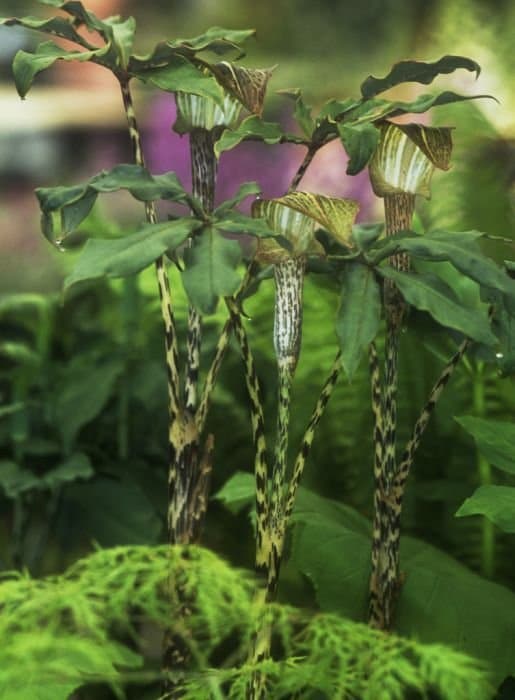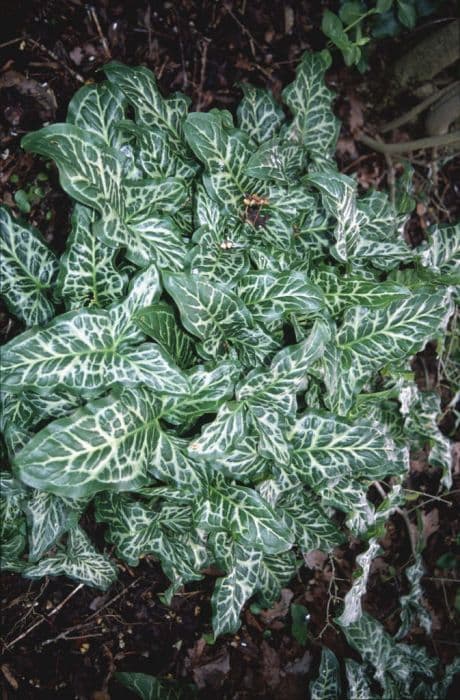Calla Lily 'White Flirt' Zantedeschia 'White Flirt' (PBR)

ABOUT
Zantedeschia 'White Flirt', commonly known as a Calla Lily, has a striking appearance. This plant is characterized by its large, trumpet-shaped flowers, which are a pure, crisp white. The blooms emerge from a singular, long, and slender stem, which unfurls into an elegant and smooth spathe, showcasing a faint creamy yellow spadix at its center. The leaves are glossy and arrow-shaped, often displaying white speckled patterns that provide a beautiful contrast to the deep green foliage. The overall appearance of 'White Flirt' is one of grace and distinction, as this Calla Lily cultivar exudes a sense of serenity and sophistication through its immaculate flowers and attractive leaves.
About this plant
 Names
NamesFamily
Araceae
Synonyms
Calla Lily, Arum Lily
Common names
Zantedeschia 'White Flirt' (PBR)
 Toxicity
ToxicityTo humans
The calla lily, including the Zantedeschia 'White Flirt' (PBR) variety, is toxic to humans. If ingested, it can cause symptoms such as burning and swelling of the lips, mouth, and throat, as well as nausea, vomiting, and diarrhea. In severe cases, difficulty swallowing and speaking might occur due to throat swelling.
To pets
The calla lily, which includes the Zantedeschia 'White Flirt' (PBR), is poisonous to pets, such as cats and dogs. Symptoms of poisoning can include oral irritation, intense burning and irritation of the mouth, tongue, and lips, excessive drooling, vomiting, difficulty swallowing, and in severe cases, a potentially life-threatening swelling of the airways.
 Characteristics
CharacteristicsLife cycle
Perennials
Foliage type
Evergreen
Color of leaves
Green
Flower color
White
Height
1-2 feet (30-60 cm)
Spread
1-2 feet (30-60 cm)
Plant type
Herb
Hardiness zones
8
Native area
South Africa
Benefits
 General Benefits
General Benefits- Attractive Blooms - Produces elegant, white, trumpet-shaped flowers that add beauty to any garden setting or as cut flowers in arrangements.
- Extended Flowering Season - Offers a long blooming period from late spring to early autumn.
- Low Maintenance - Requires minimal care once established, making it ideal for busy gardeners or those new to gardening.
- Drought Tolerant - Once established, it can withstand periods of dryness, reducing the need for frequent watering.
- Compact Size - Its small stature makes it suitable for container planting or small gardens with limited space.
- Versatile - Can be grown both outdoors and indoors given the right conditions, providing flexibility in landscaping and interior decoration.
- Deer Resistant - Less likely to be eaten by deer, making it a suitable choice for gardens in areas with high deer populations.
- Attracts Pollinators - Attracts bees and butterflies, which are essential for pollination and maintaining a healthy ecosystem.
 Medical Properties
Medical PropertiesThis plant is not used for medical purposes.
 Air-purifying Qualities
Air-purifying QualitiesThis plant is not specifically known for air purifying qualities.
 Other Uses
Other Uses- Zantedeschia 'White Flirt', commonly known as the calla lily, can be used in art and photography as a subject due to its elegant and pristine appearance, providing an ethereal and minimalistic aesthetic.
- Pressed calla lilies can be incorporated into handmade paper, creating unique textures and patterns for decorative stationery or gift wrapping.
- Calla lily petals can be turned into natural dyes or inks for textile and craft projects, offering a soft color palette derived from the plant's pigments.
- As a symbol of purity and sympathy, calla lilies are used in bereavement floral arrangements and remembrance events to honor and remember loved ones.
- Calla lilies are popular in fashion design, inspiring patterns, and motifs for fabrics, accessories, and even jewelry, because of their sleek and iconic form.
- These flowers are used as natural decorations for festive occasions, like birthdays or anniversaries, adding sophistication without additional embellishments.
- During special events, calla lilies can be floated in large decorative bowls of water as part of a serene and elegant table centerpiece.
- With their long-stemmed grace, calla lilies can serve as a natural and biodegradable confetti alternative at weddings when gently pulled apart by guests.
- In culinary arts, sugared or candied calla lily petals can adorn desserts and cakes, although they are not edible in their natural state and should only be used for decorative purposes.
- The calla lily is often used as a living sculptural element in interior design, providing a touch of organic sophistication to modern living spaces.
Interesting Facts
 Feng Shui
Feng ShuiThe Calla Lily is not used in Feng Shui practice.
 Zodiac Sign Compitability
Zodiac Sign CompitabilityThe Calla Lily is not used in astrology practice.
 Plant Symbolism
Plant Symbolism- Purity: The white color of Zantedeschia 'White Flirt', more commonly known as Calla Lily, often symbolizes purity and innocence, making it a popular choice for weddings and christenings.
- Beauty: Calla Lilies are known for their elegant trumpet-shaped blooms, which are associated with beauty and sophistication.
- Resurrection and Rebirth: Due to its trumpet-like shape, the Calla Lily is often connected to resurrection and rebirth, especially in Christian symbolism around Easter.
- Faith and Devotion: The Calla Lily's sturdiness and perennial nature make it a symbol of faith and devotion, qualities that endure over time.
- Marriage and Fidelity: Owing to its purity connotations and aesthetic, the Calla Lily often represents the concepts of united marriage and fidelity.
- Transition and Change: As a flower that emerges from a bulb and blooms into a striking plant, the Calla Lily can symbolize transition and change, representing personal growth or life changes.
 Water
WaterThe Calla Lily, commonly known as Zantedeschia 'White Flirt', should be watered regularly to maintain evenly moist soil, especially during its growing season in spring and summer. Water when the top inch of soil feels dry to the touch, which may be approximately once a week, but this can vary depending on climate and indoor conditions. Provide the plant with about a half gallon of water per watering session, ensuring any excess water can drain away to avoid waterlogging. Reduce watering in the fall and winter when the plant is dormant. Always use room temperature water to avoid shocking the roots.
 Light
LightCalla Lilies prefer bright, indirect sunlight. A spot near a window that receives filtered light or a little direct morning sun is ideal for the Zantedeschia 'White Flirt'. However, shield it from harsh midday and afternoon sun as this can scorch the leaves and flowers.
 Temperature
TemperatureZantedeschia 'White Flirt' thrives at room temperatures between 65 and 75 degrees Fahrenheit. It can tolerate a minimum temperature of 50 degrees Fahrenheit during its dormant period in the winter. Avoid exposing the Calla Lily to temperatures below 50 degrees, as cold can damage the plant.
 Pruning
PruningPruning the Calla Lily is mostly about removing spent flowers and yellowing leaves to encourage new growth and maintain the plant's appearance. Deadhead the flowers after they fade and cut back any yellow leaves at the base. The best time for pruning is when you notice the plant parts are spent or declining, which may occur throughout the growing season.
 Cleaning
CleaningAs needed
 Soil
SoilThe Calla Lily 'White Flirt' thrives in organically rich, well-draining soil with a slightly acidic to neutral pH of about 5.5 to 6.5. A mix of two parts peat moss or coco coir, one part perlite, and one part loamy soil would create an ideal growing medium for this plant.
 Repotting
RepottingCalla Lilies like 'White Flirt' should be repotted every two years to refresh the soil and accommodate root growth. They are best repotted after the flowering period when they enter dormancy.
 Humidity & Misting
Humidity & MistingCalla Lily 'White Flirt' performs best in moderate to high humidity levels, around 50-60%. Avoid environments that are too dry, as this can cause stress to the plant.
 Suitable locations
Suitable locationsIndoor
Place near bright, indirect light; ensure pot has drainage holes.
Outdoor
Provide partial shade and shelter from strong winds.
Hardiness zone
8-10 USDA
 Life cycle
Life cycleZantedeschia 'White Flirt', commonly known as White Flirt Calla Lily, begins its life as a rhizome, which is a type of underground stem that stores nutrients. Upon planting, the rhizome sprouts roots and a shoot that emerges above the soil, developing into a sturdy stem with arrow-shaped leaves. As the plant matures, a spadix surrounded by a prominent, trumpet-shaped white spathe forms, characterizing its distinctive flowering stage. After pollination, the flowers may develop into tiny yellow or orange berries if conditions allow for fertilization. Once the blooming period is over, the plant enters a dormancy phase, where the foliage dies back and the rhizome remains dormant until the next growing season. With appropriate conditions, the cycle repeats, with the rhizome producing new shoots and leaves, leading into another flowering period.
 Propogation
PropogationPropogation time
Spring-Early Summer
The Zantedeschia 'White Flirt', commonly known as the Calla Lily 'White Flirt', is typically propagated through division, which is its most popular method. The best time to propagate via division is in the late winter or early spring just before the growing season begins. To propagate through division, gently separate the rhizomes with your hands or use a clean sharp knife to cut them, ensuring each divided section has at least one growth point or "eye." After division, the rhizome pieces can be planted about 3 to 4 inches (7.5 to 10 cm) deep in well-draining soil and spaced approximately 12 inches (roughly 30 cm) apart to allow sufficient room for growth. Water the rhizomes thoroughly after planting to help establish them. This method allows the Calla Lily 'White Flirt' to preserve the characteristics of the parent plant, ensuring a consistent display of its desirable white blooms.









